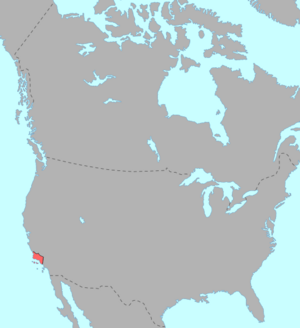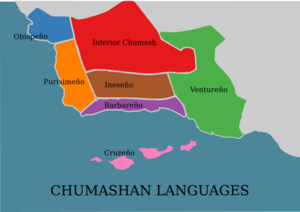Chumashan languages facts for kids
Quick facts for kids Chumash |
|
|---|---|
| Ethnicity: | Chumash |
| Geographic distribution: |
southern coastal California |
| Linguistic classification: | One of the world's primary language families |
| Subdivisions: |
Northern Chumash (Obispeño)
Central Chumash (Purisimeño, Ineseño, Barbareño and Ventureño)
Island Chumash
|
 Pre-contact distribution of Chumashan languages
|
|
The Chumashan languages were a group of languages spoken by the Chumash people. The Chumash are Native American people who lived along the southern coast of California. Their lands stretched from San Luis Obispo down to Malibu. They also lived in nearby valleys and on three Channel Islands: San Miguel, Santa Rosa, and Santa Cruz.
These languages are thought to be some of the oldest language families in California. The Chumash people have lived in this area for a very long time, possibly over 10,000 years.
Even though the last native speaker of a Chumashan language, Mary Yee, passed away in 1965, efforts are now being made to bring these languages back to life. Language programs and classes are helping new generations learn them. Many details about these languages were written down by a linguist named John Peabody Harrington.
Contents
Different Chumashan Languages
There were six known Chumashan languages. While they are no longer spoken by everyone, many are being brought back to life through special programs. Today, Chumash people often use the original native names for their languages instead of the older names.
Northern Chumash
- Obispeño (also called Northern Chumash or Tilhini)
- This language was spoken near the area where the Mission San Luis Obispo de Tolosa was later built.
Southern Chumash
The Southern Chumash languages include Island Chumash and the Central Chumash languages.
Island Chumash
- Island Chumash (also known as Ysleño, Isleño, or Cruzeño)
- This language was spoken on the three islands in the Santa Barbara Channel: Santa Rosa, San Miguel, and Santa Cruz.
Central Chumash
The Central Chumash languages were spoken on the mainland.
- Purisimeño
- Samala (also spelled Sʰamala)
- This language was spoken by the Santa Ynez Band of Chumash.
- Šmuwič (also spelled Shmuwich)
- This name means "coastal" and refers to both the language and the people who spoke it.
- Mitsqanaqa'n
- This language was renamed by community members after a main village near where the mission was founded.
Obispeño was the most different Chumashan language. The Central Chumash languages (Purisimeño, Ineseño, Barbareño, and Ventureño) were more similar to each other. However, the way the language was spoken near each mission was unique enough to be considered a different language.
How They Got Their Names
The names of these languages often came from the Spanish missions in California where Chumash speakers were moved between the 1770s and 1830s.
- Obispeño—from Mission San Luis Obispo de Tolosa
- Purisimeño—from Mission La Purísima Concepción
- Ineseño—from Mission Santa Inés
- Barbareño—from Mission Santa Barbara
- Ventureño—from Mission San Buenaventura
Language Characteristics
The Chumashan languages are known for some interesting features in how their sounds work. For example, they have a system called "consonant harmony." This means that certain sounds in a word change to match other sounds nearby.
Vowels
The Central Chumash languages usually had six vowel sounds. These vowels followed special rules. For example, low vowels (like 'a', 'e', 'o') in a word often matched each other. If one low vowel was 'e', others in the same word would also be 'e'.
See also


